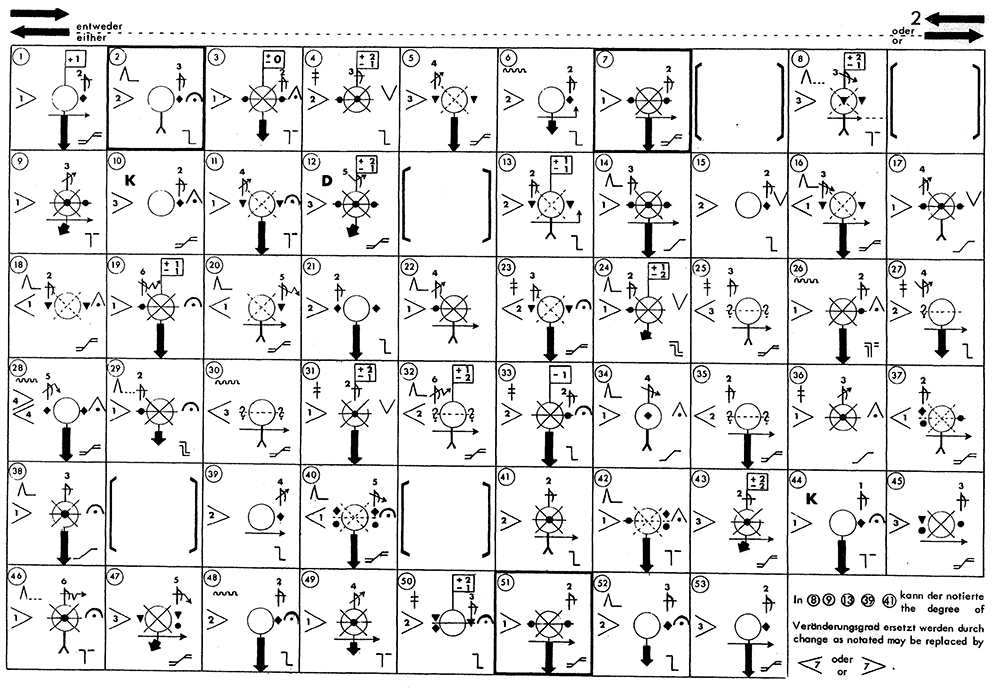Title: Plus Minus
Instrumentation: Clarinet, trumpet, trombone, guitar, piano, violoncello, accordion, percussion
Year: 2012–13
Duration: approx. 30 min.
Premiere: Wittener Tage für neue Kammermusik Festival 2013
Performers: Ensemble Ascolta
you have seen, you have opened to us a part of that world as it gave itself to you.”
Karlheinz Stockhausen in his letter to filmmakers Jean-Marie Straub and Danièle Huillet (1963)
To my knowledge, no full realization of Plus Minus exists. All of the realizations that are available (including the well known Cornelius Cardew/Frederic Rzewski realization from 1964) only address one or two pages and one layer of the Stockhausen score (there are 7 pages total with a possibility of combining up to 7 layers).
Thus elements such as “inserts”, a moment from an earlier or later page that is incorporated into the present page, as well as the synchronization of layers, which can include “pitch replacements” if two layers contain one or more of the same pitches, are ignored. It is important for these aspects to be acknowledged for one to gain a full appreciation of the complexities of Plus Minus. My version uses all 7 pages and two layers. Since this realization is for ensemble ascolta with the addition of clarinet and accordion, I have assigned Layer 1 to a trio of cello, piano, clarinet and Layer 2 to the remaining instruments.
Why realize Plus Minus today, fifty years after Stockhausen sketched its initial ideas in the sand for Mary Bauermeister? As I began interpreting the rules of Plus Minus, particularly in the context of Stockhausen’s earlier works such as Momente, Gruppen, and Refrain, I began to see Plus Minus behaving as a meta-serial work; rather than being a work that is comprised of serial ideas (which it is), its realization calls into question the nature of serial thinking.
On the one hand Plus Minus generalizes serial thought as it was absorbed by Stockhausen, which includes the attention given to all musical parameters in the work, as well as the serial shaping of a sound event by ordering and permuting the attack, central portion and decay of a sound, described in the score as accessories (Akzidens) of a “central chord” (Zentralklang), giving rise to the various musical “event types” (Ereignisse). Each event type – defined by a durational measure in my realization – consists of a serially generated central chord that appears in quantities derived from the Fibonacci series, along with subsidiary note groups (Nebennoten) and sonic qualities that shape the event such as periodic/aperiodic rhythms, pitch/noise timbres, etc. The incorporation of the plus/minus process, as a serial ordering in its most generalized form through the addition or subtraction of musical events of the same recognizable “type”, is also an important component (for example, the addition of 13 such events causes a qualitative change in that event, just as the subtraction of 13 such events causes that event to disappear and be replaced by a “negative band”). Furthermore, we find transposition rules for each event to guarantee that pitch or other parametric materials (duration, amplitude, impulse density) continually changes, as well as pitch replacement rules to guarantee that no pitch doublings or octave relationships exist. Finally, “inserts” which suggest that musical form itself is a series of “moments” that can be ordered and permuted in various ways also are a key element.
On the other hand, Plus Minus can point to the limitations of serial thinking by incorporating the idea of the “negative band” material into its very structure. As one subtracts away the given Stockhausen material – the central chords – through the minus process, a negative band material replaces it. This material must be fundamentally different from the material given by Stockhausen and can lie outside the serial parameters of the work. Past realizations have interpreted the negative band material as something that lies outside the confines of the work itself: radio noise, spoken text, quotations of classical and pop music, etc. These interpretations too easily date Plus Minus as a 1960’s work by confronting the Stockhausen material with materials that are categorically at odds with it.
My opinion is that, for Plus Minus to continually be relevant today, the negative band material should be interpreted freely through a composer’s own musical language. In this way, a composer enters into a dialogue with the rules of Plus Minus that truly makes it a living work animated by the energy produced by one’s confrontation with, and working out of, Stockhausen’s serial materials. This is how I interpreted the negative band material, within my own musical language and materials that shape and become shaped by the rules of Plus Minus. Yet as the negative band material itself is subtracted, my own presence is gradually erased from the work through the noise of bowed timpani drums that act more as sonic ‘facts’ that lie outside the dialectics of the work’s progression. This self-reflexive quality of the negative band material that at first erases Stockhausen’s presence then gradually my own, lifts Plus Minus above those ‘open scores’ from the 1960’s that remain merely interesting into the realm of a philosophical music where serial structuring encounters an awareness of its own conditioning.
Link: www.wisemusicclassical.com/work/66099/Plus-Minus–Ming-Tsao/


